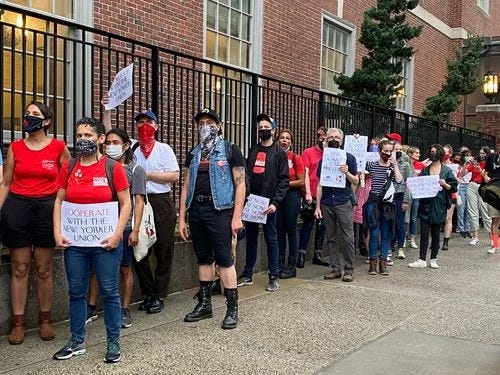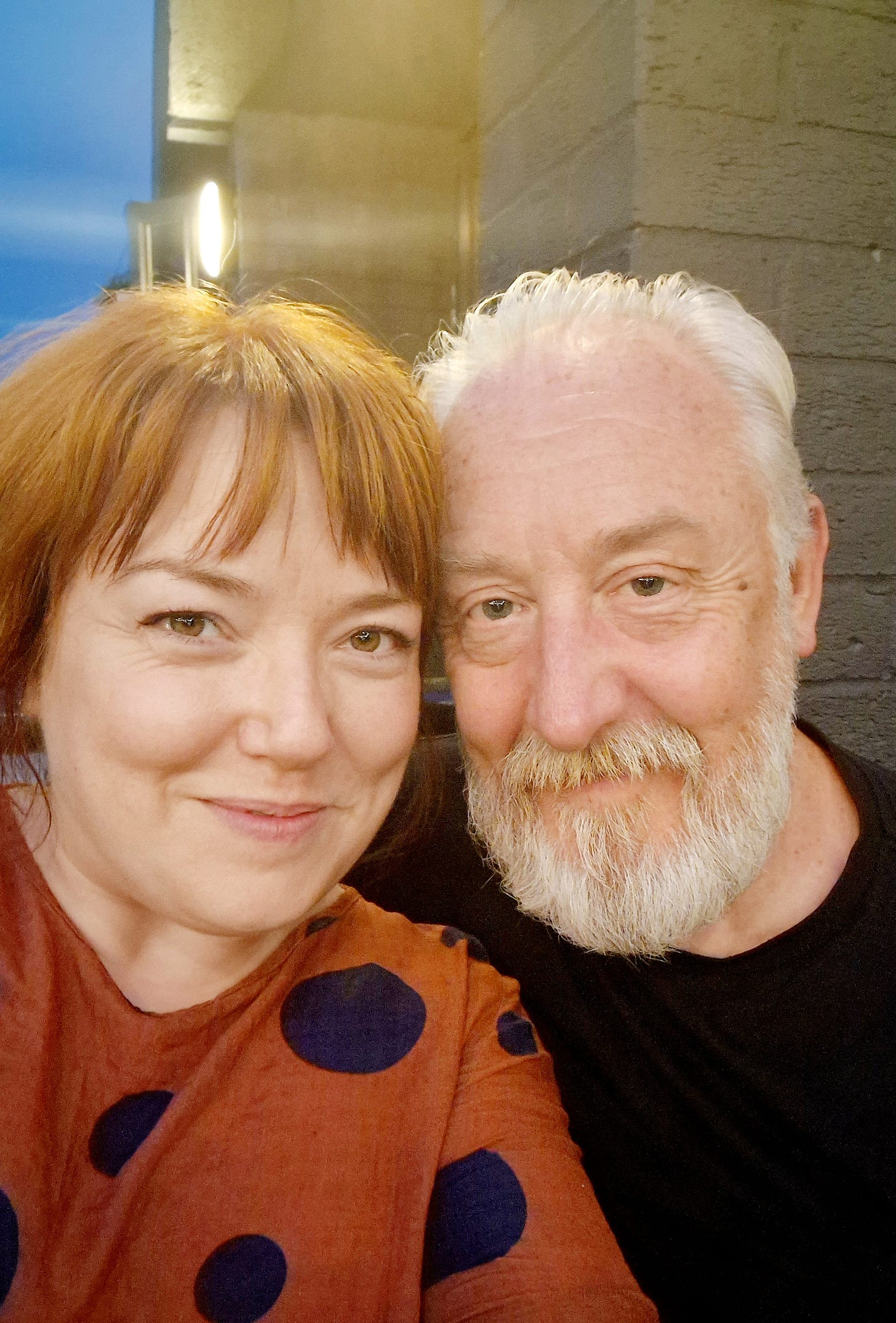School children from my era were taught that labor unions weren’t necessary for this modern era. Sure, once upon a time they had value. They got rid of child labor, got us the forty hour work week and helped to build the middle class. But all of that was behind us. We were taught that unions were corrupt and run by the mafia. They featherbedded factories and transportation industries. Besides, we were heading into the Information Age and you don’t unionize offices, do you?
So teenaged me was a bit surprised when the workers at the magazine, book and newspaper distribution company my father managed decided to unionize and my Dad’s response was “OK, we can can make that work.” When I looked confused at his response he pointed out that my Mom, an elementary school teacher, was in a union. He said he liked the idea of working with representatives of the entire labor force in his warehouse. He thought there might be more accountability and the fact that now that they had to negotiate with management, they’d have to understand how the business operated.
I’m named for my great grandfather who emigrated to this country from Ukraine in the late 1890’s. He settled his family in Haverhill, MA and went to work in the Lawrence, MA textile factories. For many years, that’s all I really knew about him until late in his life, my father finally began to tell us stories about his grandfather getting injured during the textile strikes of 1912.
I bring all of this up because it’s been interesting to watch this decade unfold and to see unions making a comeback and cropping up in newsrooms and magazine offices. The magazine industry has consolidated and we’re seeing writers at the few remaining major publishers setting up unions. Similar developments are taking place at digital news operations.
The number of indie bookstores in this country has grown since the demise of Borders and not surprisingly these retail workers are also getting unions. Even legacy indie chains like Powells see their workers demanding more.
Where will all this lead? I’m kind of terrible at making predictions, but I’m inclined to think that 21st century unions won’t make the same mistakes that their 19th and 20th century counterparts did. This is a very different world. There’s less back breaking heavy industry and more access to knowledge and information. Ultimately, this could be a good thing that lifts workers and gives them a legitimate voice in their employment.
Five Questions with Peter Houston & Joanna Cummings
It’s the second Tuesday of the month, so let’s go and meet some people you should know if you’re going to spend any time in the world of magazine media. In fact, let’s jet across the “pond” and meet two people who are making a big impact in our business: Peter Houston and Joanna Cummings.
Why should you know them?
Peter Houston and Joanna Cummings are the publishers of The Grub Street Journal. They describe the title as “Brutally honest, but relentlessly optimistic.” It is a magazine is for people who love magazines. The premiere issue was launched this past April 1st, partly, they say, to sound really cool at parties, but mostly to understand the pain points involved in publishing an indie print magazine.
Away from Grub Street, Joanna is a freelance writer and editor writing mostly for geniuses, whether they are MENSA members or PHD scientists. Peter knows his limitations and writes mostly for people in the media business. He is one third of the Media Voices podcast.
Let’s go and meet them…
Here’s a lightly edited version of our conversation with Peter & Joanna…
Q1: How did you get into the magazine media world? Did you have any specific training that prepared you for your first job in magazines?
PJ: 100% by accident. I followed my girlfriend to Hong Kong and after teaching Cantonese kids to speak English with a Scottish accent for a month, I found a job as a sub on a trade magazine. Being a native English speaker was my only real qualification, but I absolutely loved the work. That was in 1987.
JC: I took a slightly more traditional route. After an early career in library management – including lots of storytelling – I did the Edinburgh Napier MSc in Publishing as a mature student. I started out as a ‘book person’, but got the magazine bug while developing Napier’s first magazine app. I loved the pace, the variety, and the idea of collating content into the perfect package for a reader. Still do!
Q2: What trends developed this year in the industry and how well do you think we handled it? What challenges do you think we’ll encounter over the next few years?
PH: AI is interesting, but not the general generative dog pile; I’m way more interested in publishers that are training their own bots. From the screw ups within AI content creation to the implosion of the social media network formerly known as Twitter, I think the universe is sending publishers so many signs that there are no shortcuts left. The challenge will be to focus on the real work - content, audience, revenue - and stop chasing scale-based rainbows.
JC: Not a trend as such, but I think we’re at a crunch point in terms of DEI. At the moment, publishers are focusing on the diversity aspect (though not often very well), but doing even less to make sure the industry is also equitable and inclusive. It’s still very white, middle class and male, of course, but we need to do much more to both improve access to the industry and platform people in underrepresented groups. To do that we need to fundamentally change how it all works, and the challenges for that are numerous. There are lots of groups doing brilliant work in this area, but we need the whole industry to work together, rather than on an organisation-by-organisation basis.
Q3: Do you think print magazines will have much of a future over the next decade? Will there be print magazines twenty years from now?
PH: Absolutely, but they will continue to evolve to be more niche, less regular and with excellent production. There will always be print - five years, 10 years, 20 years - but the titles that survive and thrive will be those that achieve a strong blend of what print does best and what digital does best. We’re still trying to figure that out with The Grub Street Journal.
JC: What Peter said! People still seem to appreciate print, but are looking for specialist, less generalised titles that make them feel they belong. The challenge – as we are experiencing with Grub Street – is to get readers to pay for them.
Q4: If you hadn’t had a career in magazines, what would you have wanted to do?
PH: A stained glass window artist. The mix of materials and light is magic. Depending on what happens with Grub Street, I might retrain.
JC: A child psychologist, a personal stylist, a literacy advocate, or a textile artist. But I can’t really think of a better job that combines all my loves and skills than magazines, to be honest!
Q5: Did you have a mentor when you started out in the business (And do you want to give them a shoutout)? What was a good piece of advice they gave you?
PH: I was incredibly lucky to work with Abe Peck early in my career. Abe visited Hong Kong from Northwestern’s Medill School of Journalism every year to work with my employer’s editorial teams. We bonded on the dance floor of a Wan Chai nightclub, busting our moves to Smoke on the Water. Not sure it counts as advice, but over the years in Hong Kong and a term I spent at Medill, Abe taught me to be a journalist and editor, not just a language technician.
JC: Oddly enough, Peter was my unofficial mentor when I started out. I saw one of his lectures while at Napier, and really appreciated his mix of honesty and idealism, so I kept in touch. He gave me my first freelance jobs as a graduate and played a part in me getting my first ‘proper’ job in magazines – something he’s pretty smug about. Even now he’s pretty good at advising me and spurring me on, though I like to think it’s mutual these days.
Best advice? “Leave that magazine job that’s burning you out.” Advice that seemed iffy at the time but turned out to be a winner? “Go for this analytical chemistry editor role, even though you hate science”...
Your moment of magazine zen is brought to you by…
I hope you enjoyed this newsletter. Please “Like” and subscribe. You’ll get a brand new release in your email in-box every Tuesday (Or sometimes Wednesday, if things get a little hectic around here).
Want to find me on the social sites?
My Instagram link is here.
I’m now hanging out at Post.News and you can find me here on their app.
Every now and then I get to put on a suit and tie and comb my hair. Here’s my LinkedIn profile if you want to see me looking all professional.
Thanks to a generous reader, I recently got access to Blue Sky. But I confess, do I really want a “sort of” clone of the old Twitter? “Notes” here on Substack…I can’t say I feel all that enthusiastic. Is Threads worth it? Do I really want to spend that much time on social media anymore? I’d love to hear your thoughts on all of this.
That’s all I’ve got for you this week. And you know, now that we’re well inside the month of September, you can head down to the break room and warm up that pumpkin spice latte in the microwave. No one will give you a hard time. Go on, go for it!






